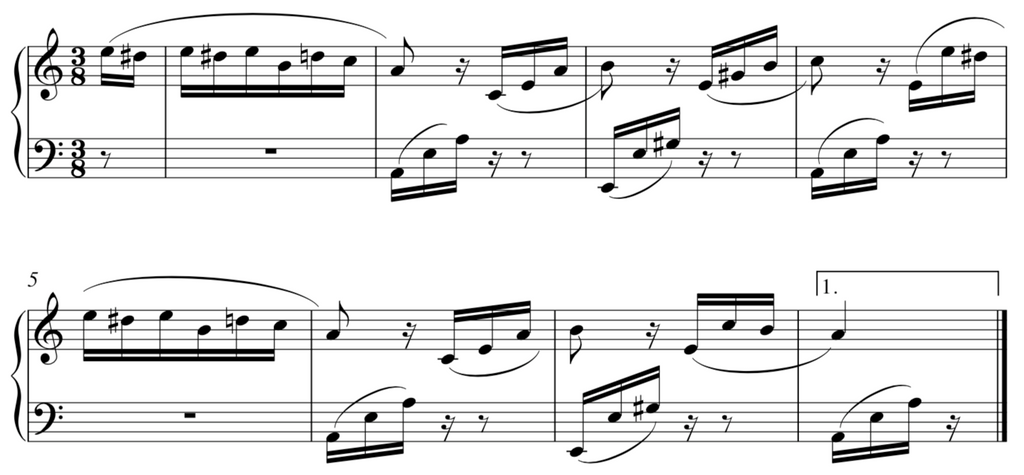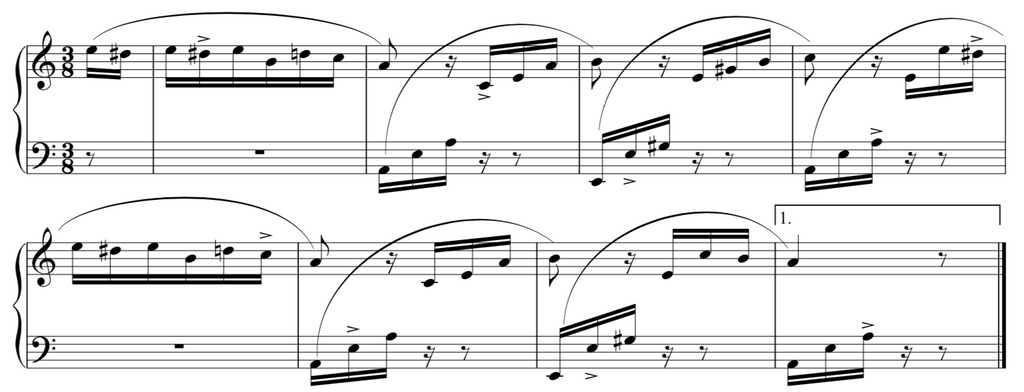How To Play Fur Elise. A Proven Step-by-Step Tutorial for Adults. Part 1.

Before You Begin
Perhaps the most famous piano piece in the world would be Fur Elise (correctly spelt Für Elise).
It was composed on the 27th April 1810 by Ludwig Van Beethoven and published in 1867, forty years after the composers’ death.
Fur Elise is played all over the world by amateurs and professionals alike. Playing just the opening three notes, children and adults instantly recognise this Bagatelle in A minor.
There is much speculation as to who “Elise” was. One such claim by the researcher Ludwig Nohl said he saw the name Elise on the original autographed manuscript. Others believe that this was misread due to Beethoven’s messy handwriting, and it was written for Therese Malfatti to whom he had proposed in the same year, but she had declined his offer.

What You Will Learn
This blog post will teach adult learners of all levels How to Play Für Elise in a technically correct way. It has three parts.
Part 1 will teach you the following:
- Technique
- Phrasing
- Articulation
- Dynamics
- Pedalling techniques
There are several audio tracks to help you train your ears to increase your chances of playing Für Elise to a professional level as well as helping you become a better all-round piano player.
Part 2 starts at the very beginning, using a series of technical videos, for both right and left hands and hands together, taking you step-by-step to learning the first part, section A, of Fur Elise. This would suit beginners wanting to begin learning this wonderful piece of music or for those who have already learnt it but would like to double-check their playing technique.
Part 3 is taken directly from The Complete Classical Piano Course and will suit adult players of an intermediate standard, who are confident at reading 3/8 time signature but would like a more detailed explanation on how to tackle sections B and C.
In Part 3 you will learn:
- Structure
- Playing Sixths
- Arpeggio Techniques
- Repeated Notes
- Page Turns
- Ornaments
- Aural Training
- 3/8 Rhythm
- How to Work with the Metronome
Since most people learn this tune from YouTube or through a friend, How to Play Für Elise: Part 3 is designed to help you finish learning the entire Bagatelle in A minor in its original Rondo form, i.e., ABACA form. Learning just the A section in How to Play Für Elise: Part 2 and playing it in 3/4 a pianist would only be just touching the surface of this piece.
NOTE: Use earphones or a good set of headphones to listen to the audio examples. If you play the tracks straight from laptop or PC speakers you won’t be able to hear the subtle nuances within the music.
Let’s get started.
TECHNIQUE
To be good at anything requires having good technique. Anyone can hit a tennis ball over the net, but getting that 'topspin' like the pros requires skill, time, patience, dedication and desire.
So, ask yourself. Do you want to just hit the ball over the net or do you want to hit it over the net with 'topspin'?
Most people learning Für Elise or any music from YouTube videos are happy to just hit the ball over the net, i.e., just playing the notes. But learning by yourself from YouTube videos will only get you so far. Most videos will only teach you the notes and nothing to do with the technical aspects of playing. Because of this fact, the player will only learn in the most basic way, i.e., monotone style.
Let's play a game. Spot the Difference.
Below are two audio examples from the A section of Für Elise. Listen to each example and answer the following questions. Choose wisely as you are only allowed one attempt.
If you preferred Audio 2 over Audio 1, it's probably because Audio 1 sounded monotone. In other words, bland. This is because the notes were all played at the same volume... not very interesting. This how most people learn to play Fur Elise from YouTube videos.
NO EXPRESSION=NO EMOTION
There's a lot more to playing music than just playing a group of notes together.
Listen to Audio 1 and Audio 2 again, and see if you can hear these differences.
In Audio 2.
- The left hand is played at a lower volume allowing the melody in the right hand to be heard.
- A slight ‘lilt’ is played, i.e., some notes are a touch louder than others.
- Notes are played slightly heavier/quieter than others.
- Notes get louder or quieter as they ascend or descend.
How Can You Create Passion In Your Music?
By adding in
Phrasing, Articulation, Dynamics, and Pedalling.
In Audio 2 these four key elements were added to make the music sound a whole lot better and these elements could not be added if the music was not played with good Technique.
Listen to each track again and ask yourself if you're playing Fur Elise with or without Phrasing, Articulation, Dynamics and Pedalling.
Do you play with Phrasing, Articulation, Dynamics and Pedalling?
PHRASING
Think of phrasing like a sentence. You start at the beginning, adding a slight pause at the comma, and finish on a full stop.
Just as you read these words, you have to play music thinking the same way. This could be when you are playing someone else's music, composing your own or perhaps just improvising on the piano.
Phrasing always has a start, (sometimes middle) and end. Most of the time the music will have a curved line, known as a slur, above or below the notes.

Listen to these two examples and ask yourself which one do you think sounds wrong to you.
When playing notes, you have to think about which notes are more important than other notes.
ARTICULATION
To communicate well requires good articulation skills. Since music is a language it requires the same articulation skills as one does when speaking.
Articulation is based on how one plays the notes. This could be by playing smoothly using slurs, staccatos and accents. Since Fur Elise has no staccatos written in the music let's concentrate on the slurs and accents.
When we talk, we accent certain words that are more important than other words. In music, you have to find out which notes are the most important.
Audio 3 Here's Fur Elise again but articulated incorrectly. Doesn't it sound odd? This is because the accents are placed on notes that are not as important. Look at the music below to see where the accents were placed.

Do you phrase your music like this? If we translated music into words, you may be articulating your music like this Once Upon a Time. The last one sounds correct because the accents were placed over the important, i.e., more interesting words.
Listen to Audio 4 again, and hear where the accents should fall.
How Do You Know Where To Place The Accents?
A general rule of thumb is to place the accent on the first note/beat of every bar.
Listen to this next track Audio 5 and notice where notes C and B at the end of bar 7 creates a diminuendo. Making the note A on the first beat in bar 8 sound softer. This is just musical taste. To play in this way will take some training in piano technique.
DYNAMICS
Placing accents only on the first beat of every bar will only get you so far. You need to add Dynamics.
Play Audio 1 again, and listen to how each note is played at the same volume, creating a bland musical performance.
Listen to Audio 6. Just adding Dynamics to the music, you can hear that Fur Elise comes alive! Can you hear...
- The left hand is played at a lower volume allowing the melody in the right hand to be heard.
- Notes are increased or decreased in volume.
I also added accents at the start of each bar to create the 3/8 feel.
Audio 7 Most people don't listen out for the left hand playing too loudly. You can hear in this example that the melody in the right hand isn't very clear.
As A General Rule Of Thumb
Whenever the melody goes up then use a Crescendo.
Whenever the music goes down then use a Diminuendo.
PEDALLING
Using the sustain pedal (far right pedal) creates a warmer sound to any music played, creating ambience. You have to always listen out for how much pedalling is required. It's not meant to be a footstool!
Also,
The Pedal Should Not Be Used To Cover Bad Playing Technique
Listen to these audio examples and ask yourself, which one do you prefer?
Which one do you prefer?
Audio 8 uses no pedal at. This sounds ok, but there's no warmth to the music.
Audio 9 uses the pedal on every note. You can hear how 'muddy' the notes become, making the notes unclear.
Audio 10 uses the pedal at the start of every bar. Creating a 'warmer' feeling but not too much as to muddy the notes.
CD3-Track 29-29.1 Listen to the following improvised piece of music which is taken from The Complete Classical Piano Course. At first, everything sounds connected and smooth, but in reality, without the pedal, it was played like the last one.
First, learn how to play with good technique and then perhaps you can break the rules a bit.
FINALLY
Is There A Right Or Wrong Way To Play Fur Elise?
The answer is Yes and No. My way of playing Für Elise is not the only way. It's just one way. Two people playing Fur Elise using the same notes in the same order will always sound different from each other.
This cannot be achieved however without two things. Training in playing techniques and training your musical ear. This is all down to how much you practice the piano using Dynamics, Phrasing, Articulation and Pedalling. Remember: NO EXPRESSION=NO EMOTION and just as Beethoven said...
‘To play a wrong note is insignificant; to play without passion is inexcusable’
—BEETHOVEN
If you want to delve deeper into learning how to play Fur Elise there is How to Play Für Elise: Part 2 and Part 3. Part 2 will cover section A, the most popular part. This would suit all beginners who cannot sight-read music or those who want to check their playing technique. Part 3 covers sections B and C. This part would suit more intermediate players who can read in 3/8 time signature or beginners up for a challenge.
Interested in The Complete Classical Piano Course?
*30-day Money Back Guarantee!
You can try out the complete course for a full 30 days.
If you don't see any improvement in your piano playing or for any reason you don't feel that this course is for you, even after trying out the books, the audio CD's and the online videos, you can return the books and CDs with no questions asked for a full refund! *See refund policy.
If you liked this tutorial on how to play Für Elise, please, leave a comment below!
And don't forget to bookmark the page!
Interested in learning more?
- MASTER your TECHNIQUE with our new online course Piano Playing Techniques
- Learn how to Play by Ear: Playing By Ear: A Songwriter's Way
- Learn how to improvise Jazz piano Jazz Piano Improvisation Series
- "HOW TO PLAY" series with PIANIST magazine: How to play contemporary classical piano music



Hello, I have been learning this song for 6 months however I have having some trouble with getting the tempo in time. I found the article really interesting and it gave insightful tips with the playing. I have been following the tempo of 104 but am finding it hard to get into time.
Answered a lot of questions. I play many different styles and instruments. Like the presentation. I did a tutorial on this s year ago. It was just a song..I wanted to get all of it down. But I did not pay attention to Dynamics etc. I may take the course one of these days.
Thank you Mr Cotterill for your very nice comment. It’s never too late to start! You can try out The Complete Classical Piano Course for a full 90 days. If you find that the course is not for you then simply return the course for a full refund.
I found this tutorial interesting and enlightning.The Fur Elise was one of my favourite pieces when I was taking lessons as a youngster between eleven and seventeen years of age.I am now eighty three and recently returned to the piano.I am seriously considering purchasing the Complete Classical Piano Course,or am I to old at eighty three.